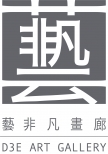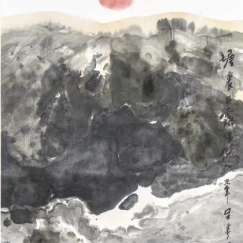Timeline
| 1919 | Born in Guangdong, China |
| 1946 | Graduated from university in Guangzhou with a degree in EconomicsOrganised the Kwangtung Flood Charity Fund Chinese Painting Exhibition in Canton, China |
| 1948 | Moved to Hong Kong |
| 1949 | Joined the Hong Kong and Yaumatei Ferry Company, working as an inspector |
| 1952 | Contributed articles on art and reviews on art exhibitions to local newspapers |
| 1956 | Published “A Study of Chinese Painting” |
| 1957 | Became member of the Society of Hong Kong Artists |
| 1958 | Organised adult art classes at the Chung Shan Middle School, Hong Kong |
| 1959 | Invited by the Modern Literature and Art Association to be its honorary advisor |
| 1962 | Honorary advisor to the City Hall Museum and Art Gallery (later re-named the Hong Kong Museum of Art) |
| 1966 | Resigned from the Hong Kong and Yaumati Ferry CompanyTaught Chinese ink painting at the University of Hong Kong, Department of Architecture, on a regular part-time basisTaught ink painting courses at the Chinese University of Hong Kong, Department of Extramural Studies |
| 1968 | His students of the Extramural courses formed the “In Tao Art Association” and presented its first group show |
| 1970 | Another group of his students of the Extramural Courses organised “Painting in the Chinese Tradition” exhibition and later formed the “One Art Group” |
| 1971 | Awarded an MBE by the British Government for his contribution to the arts |
| 1972 | Published “Lectures on Ink Painting” |
| 1975 | Died in Hong Kong on 26 September |
Lui Shou Kwan (Lu Shoukun) (呂壽琨) was born in Guangzhou in 1919. His strong interest in Chinese paintings was inherited from his father, Lui Ts’an Ming, a reputable scholar-painter who also owned an antique shop. However, Lui often regarded himself as a self-taught painter who built up his painting techniques and extensive knowledge about traditional Chinese paintings by constantly studying and copying the classical works largely provided by his father’s antique shop. He moved to Hong Kong in 1948. He worked for the Hong Kong and Yaumati Ferry Company as an inspector for 17 years. Meanwhile, he continued to paint and frequently contributed articles on art and reviews on art exhibitions to local art-related publications. He published his first book “A Study of Chinese Paintings” in 1956. By constantly learning from various Chinese and Western ancient masters and contemporary artists diligently, he gradually developed his unique style of abstract ink painting. Lui began to teach Chinese ink painting at the Department of Architecture of the University of Hong Kong and the Department of Extra-Mural Studies at Chinese University in 1966. He emphasized on the originality and individuality of an artist by advocating the concepts of spirituality and inspiration of traditional Chinese paintings. He has inspired innumerable ink artists such as Wucius Wong, Irene Chou and Leung Kui Ting. Largely because of his contributions, Hong Kong became the birthplace of a new style of modern Chinese ink painting. The accomplishment of a series of the highly original and unmistakable Zen painting in the 1960s marked a new milestone of the artist’s career. They were characterized by free calligraphic brushstrokes and ink washes as well as the recurrence of Taoist and Buddhist motifs such as lotus and flame. Lui successfully pushed the boundaries of Chinese ink painting. His paintings demonstrate universality and spirituality, enabling them to have timeless appeal.
Selected Solo Exhibitions
| 2013 | Lui Shou Kwan – Zen Ink Art, Alisan Fine Arts, Hong KongLui Shou-Kwan – Zen Ink Art at Fine Art Asia |
| 2002 | Retrospective exhibition “Lui Shou-Kwan – New Ink Painting” at Hong Kong Museum of Art, Hong Kong |
| 1988 | Alisan Fine Arts, Hong Kong |
| 1985 | Hong Kong in Ink Moods, Fung Ping Shan Museum, Hong Kong |
| 1984 | Alisan Fine Arts, Hong Kong |
| 1982 | Ashmolean Museum, Oxford, U.K.; Satori Gallery, San Francisco, USA |
| 1980 | Gallery Eighties, Toronto, Canada |
| 1977 | Talbot Rice Arts Centre, Edinburgh, UK |
| 1976 | “The World of Lui Shou Kwan”, Retrospective Exhibition, Hong Kong Museum of Art, Hong Kong |
| 1974 | Ashmolean Museum, Oxford, UK |
| 1973 | Covent Garden Gallery, London, UK |
| 1971 | CJL Gallery, Hong Kong |
| 1970 | Hugh M. Moss Ltd., London, UK |
| 1969 | Museum and Art Gallery, Newport, UK; South London Art Gallery, London, UK |
| 1968 | Glynn Vivian Art Gallery, Swansea, U.K.; Portsmouth City Art Gallery, Southsea, UK |
| 1967 | Sally Jackson Gallery, Hong Kong; Ashmolean Museum, Oxford, UK, Scottish National Gallery of Modern Art, UK |
| 1965 | Museum and Art Gallery, Hastings, U.K.; New Metropole Arts Centre, Folkestone, UK |
| 1964 | Hong Kong Museum of Art, Hong KongLuz Gallery, Manila, PhilippinesAbbot Hall Art Gallery, Kendal, UKRoland, Browse & Delbanco, London, UKCity Art Gallery, Bristol, UKCity of Nottingham Gallery, Nottingham, UKBangor Art Gallery, Bangor, North Wales, UK |
| 1963 | Sino-American Cultural and Economic Association, Taipei, TaiwanCommonwealth Institute, Edinburgh and London, UK |
| 1962 | Ashmolean Museum, Oxford, U. K.; Queen’s University, Belfast, UK |
| 1961 | Parkinson Court, University of Leeds, UK |
| 1960 | Stanford Research Institute, California, USA |
| 1959 | Atherton Gallery, Menlo Park, California, USA |
| 1957 | British Council Library, Hong Kong |
| 1954 | Hong Kong Hotel, Hong Kong |
• De Yong Museum, San Francisco, CA, USA
• Hong Kong Museum of Art, Hong Kong
• M. H. de Young Museum, Avery Brundage Foundation, San Francisco, USA
• Museu Luis de Camoes, Macau
• National Historical Museum, Taipei, Taiwan
• The Ashmoleum Museum, University of Oxford, United Kingdom
• The Victoria & Albert Museum, London, United Kingdom
• The Castle Gallery, Nottingham, United Kingdom
• The City Art Gallery, Bristol, United Kingdom





